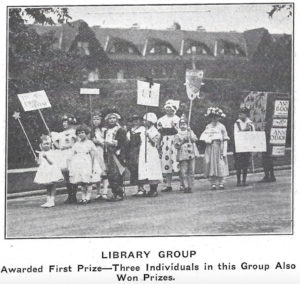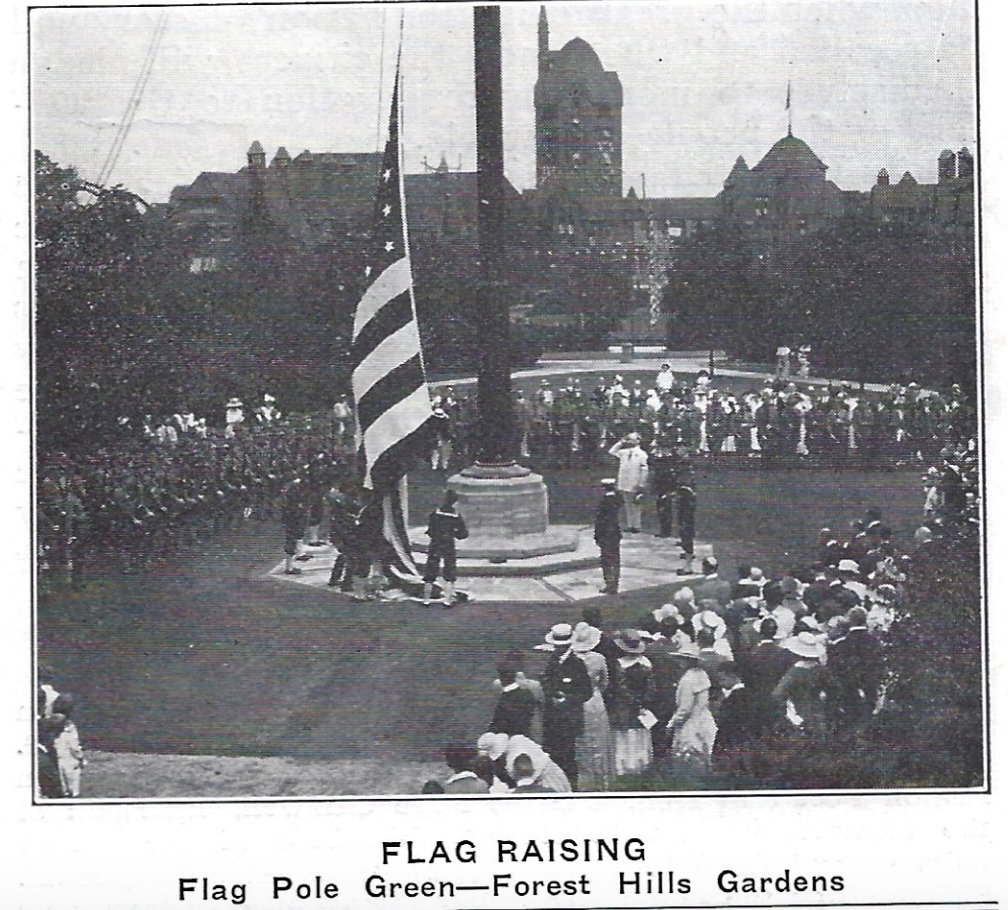By Michael Perlman
Forest Hills Gardens once hosted lavish Fourth of July Festivals from morning until midnight in Station Square and the Tea Garden, along Greenway Terrace, and in Olivia Park. This tradition was organized and sponsored by the Men’s Club of Forest Hills in 1914. One of the most historic moments transpired on July 4, 1917, when Col. Theodore Roosevelt delivered his 100 Percent Unification speech. Festivals were under the jurisdiction of The Fourth of July Committee until September 13, 1920, when the Celebrations Association of Forest Hills Gardens was organized.
A century has passed, and now it is time to turn the clock back to July 4, 1922, the 146th year of America’s independence. Numerous Forest Hills Gardens residents were integral in community affairs, and the listed names are potentially ancestors of current residents.
In anticipation, Forest Hills Gardens Bulletin stated, “All over the country there will be merrymaking, family and community gatherings, when the greatness of the nation’s history will be recalled, and when anew the citizens will pledge themselves to more sincere devotion to the welfare of the people as a whole.” It later went on to say, “In Forest Hills and Forest Hills Gardens, there will be all-day celebrations which will show that the citizens of each section have worked hard to plan a day which will not soon be forgotten.”
 For the second year, the annual celebration by the Forest Hills Association was chaired by D. McKenzie. The Monarch Band, once known as the 15th Regiment National Guard, led committee members from the Club House to the flag-raising of Forest Hills Gardens neighbors. Greetings were extended by association president W.C. Mayer and Gardens Celebrations Association Chair John Messenger. Also of note was treasurer Homer Croy and secretary Scott Robinson.
For the second year, the annual celebration by the Forest Hills Association was chaired by D. McKenzie. The Monarch Band, once known as the 15th Regiment National Guard, led committee members from the Club House to the flag-raising of Forest Hills Gardens neighbors. Greetings were extended by association president W.C. Mayer and Gardens Celebrations Association Chair John Messenger. Also of note was treasurer Homer Croy and secretary Scott Robinson.
The band led the committee and the Forest Hills Post of the American Legion to the Club House’s flag-raising ceremony. Then until 1 p.m., children had a field day with a variety of sports. Beginning at 2 p.m., a parade originating on Nome Street (now 68th Road) made its way throughout the village, and then Queens Boulevard, along Continental Avenue, and Forest Hills Gardens. Automobiles were a parade highlight, where P.D. Wright and Mrs. I.W. Backus earned first and second prizes, followed by Betty Lachman in a bicycle outfit.
Congressman Dr. J.J. Kindred addressed the challenges confronting the founders of the Constitution and requested a closer knowledge of national problems, with a will to remedy them. Afterward, a golf tournament and baseball match between married and single men was the center of attention, in addition to what was referenced as a “magnificent daylight display of fireworks.”
Tennis is synonymous with Forest Hills history. Many matches led to tennis finals, that would take place at the Seminole Avenue Clubhouse courts.
A grand march was assembled in an exquisitely decorated fairyland pavilion. Despite rain for the first in nine years of July 4th festivals, attendees enjoyed their experience overall, and the Forest Hills Masonic Temple (later Sterling National Bank) on Continental Avenue accommodated the largest crowd ever.
The Bulletin read, “After being aroused by the picturesque town criers, the villagers met on the Green and were inspired by the Flag Raising exercises (9:30 a.m.) and the eloquent address of Dr. Albert Sheppard, pastor of the Presbyterian Church of Forest Hills, who spoke of the way the really great men are maligned in their own day. With the (thirty-piece) band accompaniment, the Forest Hills Choral Club gave a program of patriotic music.”
Part of the festivities was a two-day event that was referred to as an exhibition of moving pictures of the 4th of July celebration in 1921.
A new 4th of July attraction in 1922 was a musical parade, led by Harvey Warren as the Pied Piper, which was followed by children dressed up as fairies and sunbeams among other costumes. This novelty was coordinated by Mrs. Donald G. Clark and S.W. Eckman, and participants received prizes. After the band marched, Uncle Sam, portrayed by Walter Hartwig and Columbia, portrayed by Ruth Davies, and a bicycle rider group and wheels and riders in patriotic colors followed. The Bulletin read, “‘Children of all Nations,’ interesting and colorful, was followed by an attractive group, the ‘Robin Hood Band’ of Exeter Street. The graceful Maypole Dance came next, pretty and attractive. The Audubon Society brought forth applause, led by a big crow and a number of little birds, the middle-sized ones carrying a birdhouse, which had been skillfully made by C.H.W. Hasselriis. This was followed by a group representing the Library Station, with a large book leading – the handicraft of Jules Gingras. The Community House float pulled by Boy Scouts elicited much praise for the makers of the model, (architect) John A. Tompkins and George H. Merrill. Last of all came Niels F. Holch pulling a small white model of the swimming pool of the Community House, and in the pool the Holch children dressed in red.”
The Tudor-style Station Square served as a backdrop for games that intrigued younger and older generations and tested prowess, endurance, and physical skill. Under Dr. W.F. Saybolt’s direction, children were happy campers, with prizes in hand. At 3:30 p.m., Olivia Park, the nature-inspired amphitheater that was often admired for its sylvan setting, hosted interpretative dances despite the rain.
The Bulletin stated, “The program consisted of a number of dances, beautifully executed by the pupils of the (notable) Chalif Normal School of Dancing, assisted by Joseph Kardos, pianist, Miss Irma Braver, soprano, Joseph Diskay, tenor, and Imerio Ferrari, baritone.” The traditional dancing in the name of patriotism in Station Square was abridged due to rain, so the ballroom of the Forest Hills Inn was in the spotlight.



